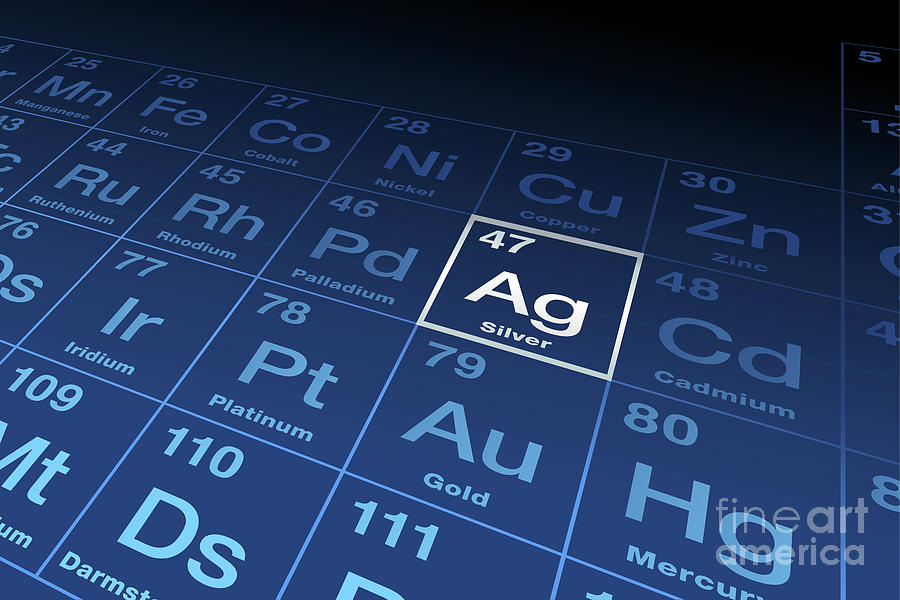

Result condition known as Argyria (the skin and mucous membranes turns purple or purple-grey). Silver compounds can be absorbed (by Chronic ingestion or inhalation) in the circulatory system and reduced silver deposited in the various tissues of the body.
/Ag-Location-56a12d923df78cf772682b70.png)
Silver itself is not toxic, But most of its salts are poisonous.Įxposure to silver in air should not exceed 0.01 mg/m 3. The Silver chloride has interesting optical properties as It darkens in bright sunlight and becomes transparent in low sunlight.ĭue to antibacterial properties, silver nanoparticles are used in clothing to prevent bacteria from digesting sweat and forming unpleasant odors. industrial consumption going into this application (producing high-quality images and protecting against illegal copying). Silver nitrate or lunar caustic is the most important silver compound, which is used extensively in photography, about 30% of the U.S. The Silver iodide is used in seeding clouds to produce Artificial rain. It is also used in dental alloys, making solder and brazing alloys, electrical contacts and and high capacity silver-zinc (Ag-Zn) and silver-cadmium (Ag-Cd) batteries.Ī Silver paints are used for making printed circuits.Ī Silver fulminate is a powerful explosive, which is sometimes formed during the silvering process. Silver is used to make mirrors, Because it is the best reflector of visible light known, but is rapidly tarnished and loses much of its reflectance with time. Sterling silver (contains 92.5% silver and remain copper or other metal) is used for jewelry, silverware, etc.

Silver from Anglo-Saxon seolfor for silver. The liquid lead oxide is removed or absorbed by capillary action into the hearth linings.Īg(s) + 2Pb(s) + O 2(g) → 2PbO(absorbed) + Ag(l) (Production) Silver History In reaction silver azide decomposes explosively and releasing nitrogen gas: Silver azide, AgN 3, formed by reaction of aqueous solution of silver nitrate with sodium azide.ĪgNo 3 (aq) + NaN 3 (aq) → AgN 3 (s) + NaNo 3 (aq) Silver metal is stable in clean air under normal conditions, as well as not react with clean water.Īg (s) + F 2 (g) → AgF 2 (s) (Silver (ll) difluoride)Īg + is precipitated by halides, that can be dissolved again in concentrated halides.ĪgCl (s) + Cl – (aq) → – (aq) + Cl – (aq) → 2- (aq) + Cl – (aq) → 3- (aq)Īg + (aq) + Br – (aq) → AgBr (s) ĪgBr (s) + Br – (aq) → – (aq) + Br – (aq) → 2- (aq) + Br – (aq) → 3- (aq)ĪgI (s) + I – (aq) → – (aq) + I – (aq) → 2- (aq) + I – (aq) → 3- (aq)ģ Ag (s) + 4 HNO 3 (aq) → AgNo 3 (aq) + NO (g) + 2 H 2O (I) Lattice constant: 408.53, 408.53, 408.53 pmįace Centered Cubic (FCC) Reactivity of SilverĮlectron affinity: 125.6 kJ/mol Nuclear Properties of Silver Ionization energies: 1st: 731 kJ.mol 2nd: 2070 kJ/mol 3rd: 3361 kJ/mol The ionization potential of an atom: 7.54 Sound Speed: 2680 m/s Atomic Properties of Silver Molar magnetic susceptibility: -2.45×10 -9 m 3/mol Physical Properties of Silverĭensity: 10.49 g/cm 3 (In solid) 9.320 g/cm 3 (In Liquid at M.P)

Mass magnetic susceptibility: -2.27×10 -9 m 3/kg Volume magnetic susceptibility: -0.0000238 Magnetic susceptibility (x mol): -19.5×10 -6 cm 3/mol Thermal conductivity: 229 W/(m∙K) Electrical properties of SilverĪ Electrical type: Conductor Magnetic Properties of Siver Silver Electron Configuration Thermal Properties of Silver


 0 kommentar(er)
0 kommentar(er)
